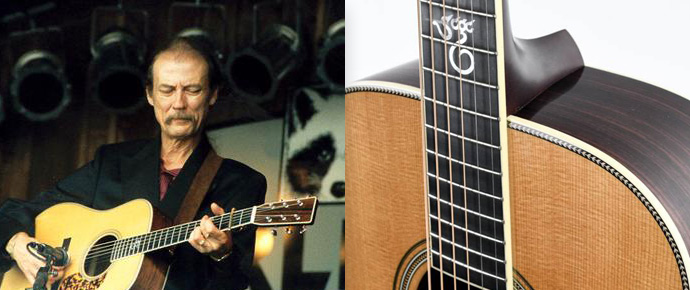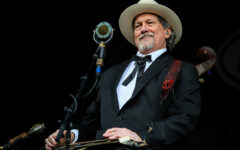
This reflection on the late Tony Rice is a contribution from Richard Hoover of the Santa Cruz Guitar Company. He and Tony became close over the development of the Tony Rice Model crafted by Santa Cruz.
Prodigious at four, incredible at 12 and ripping pretension away from tradition before 20, Tony Rice, like Coltrane playing a barn dance, he upstaged a staid musical genre and changed the way guitars have been played ever since. A big Dreadnought guitar served as the drums in early country combos keeping time while a fiddle or mandolin wove the single line melodies that gave the tunes their personality. Tony Rice changed all that.
Young Anthony Rice grew up in the bluegrass tradition with a father and brothers all dedicated to the cooperative parameters of this family-oriented genre. All fit nicely within the context of the post-war, working class culture of 1950s Southern California. This timeless influence may have stayed its course for generations save an irresistible undercurrent that would change everything. The ’60s were coming.
Populating the musical family tree, from roots in Africa, the Far East, or the dust of Mesopotamia, can be done in retrospect. We witnessed first-hand the cultural upheaval of the early 1960s which fostered an unprecedented trans-ethnic exchange of ideas thanks to a common tongue, the universal language of music. We see the direct link from an ancient Celtic culture fleeing yet another oppressor in the British Isles to Appalachia. Their music influences Clarence White in the Kentucky Colonels, and reaches the ear of Chris Hillman and the Byrds and on into the heart and the hands of Tony Rice.
Maestro Rice didn’t just pioneer new arrangements of old tunes, he had the courage to introduce an unheard-of timing and tone which he channeled through dedicated study of the music’s indigenous roots and the modern phrasing of its devotees.
With the strength in numbers from contemporaries like Doc Watson, Dan Crary, and Norman Blake, Rice forced the acoustic guitar to the front of the stage. This soulful honesty revitalized one of the most white-washed of folk-idioms. The ‘ah shucks’ de-colorization of the genre may have worked for a TV show, but a long overdue ass kicking was being welcomed on the ground.
The mastery of Rice’s work stands alone, not because of the accuracy of a perfectly timed mathematical recitation, practice, and providence will allow the reasonably gifted to accomplish that. The substance of his playing is born of his soul-felt drive to tell the story in the mother tongue. This is the language learned from his mentors, taught to them in an unbroken line since the musical dawn of time. Most of us don’t recognize the original dialects, though we’ll catch it here and there in the works of Tony’s contemporary influences. Our modern ears will find it in the RCA solos of Jerry Reed, and the tracks where Clarence White was allowed his own voice. Tony translated the more obscure code for us which he mined from thousands of hours studying rare recordings of horn, guitar, and violin riffs from masters of jump, jive, jazz, and bebop.
What makes it possible to identify a favorite guitar player after only hearing the first two, or three notes? There are an infinite number of variables in a recording studio, the room set up, instrument, strings, and microphone choices to manipulate our aural impressions. So, what is the constant that allows you to know the player? Tony’s sound signature is consistent. His tone is achieved by the controlled direction of attack of pick to string, the angle of approach from above, or below, the density and resistance of the material the string is struck with, and, to a lesser degree, the same with the composition of strings and of the guitar itself. This control of tone, a major part of Tony’s technique, is a hard-won result from studying the influence of Clarence White’s rock steady foundation and Jerry Reed’s standard of “consistency under fire.”
The second component of Rice’s inimitable sound? Well, timing is everything…the dude can swing!
Billie Holiday’s gravity defying ability to slide off and on the beat is gawdawfully arousing. Her imitators use a heroin slur that might sound similar, but it doesn’t make us squirm in our seat like Billie could. Herein lies the reason that one can distinguish between those who sound just like Tony, and Tony’s real thing. You feel it.
He wasn’t an audiophile because he was a gearhead, he wanted gear that could reproduce what ordinary sound systems missed. In an all-night listening session where Tony riffed on each solo and its context within the artists career, I asked if all his analog audio technology was of any advantage. He said, “Man…you gotta hear the shape of the notes, digital don’t do that. All this is to hear what’s behind the note…the man’s intent.”
Who knows what God’s plan B was for this writer and the Santa Cruz Guitar Company? But for the path illuminated for us by Tony Rice, you may never have heard of us at all.
Darol Anger, the internationally celebrated violinist, introduced us when we were all 25 years old. Darol got the fiddle part in the David Grisman Quintet right after Tony was recruited as guitar player for the genre busting combo of stringed instrument greats. It was 1976 when Darol left our mandolin making cooperative, and an unpromising career as a pizza pub act. I had just joined with two partners to launch the Santa Cruz Guitar Company to upend the industrialization of acoustic guitar making.
Darol brought Tony to my house to meet me, and play the fourth guitar under the Santa Cruz label. Tony was looking for a replacement guitar to allow him to leave Clarence White’s fragile old 1934 D-28 at home while he toured in support of the Quintet’s first album. Rice’s antique Martin herringbone guitar, though a legacy of the late great Clarence White, lacked substance in the mid-range and treble frequencies which Tony needed to showcase the solo jazz phrasing of Grisman’s compositions. By design, the original dreadnought size guitar was meant for holding down rhythm, and not for articulate solo work. Nonetheless Tony wanted his new guitar to look just like the old, but with updated qualities of sound.
The resulting Santa Cruz Tony Rice Model was never intended to copy the venerable old 1934 Martin, rather it was to be a Trojan Horse. That is, a friendly and familiar package disguising the danger within. Bracing, neck weight, and sound hole size were all modified to achieve an appropriate EQ, clarity of tone, and projection to compliment the “New Acoustic Music.”
The Quintet ushered in a new day for acoustic music to a public recently flogged by disco and electronic Midi-Interface that made performing musicians irrelevant. Santa Cruz Guitar Company was pioneering the boutique custom guitar market at a time when people didn’t make guitars, factories did. Santa Cruz’s Tony Rice Model was setting new standards while the baby boom was having babies and paying off student loans. Behind this bucolic setting a crippling economic recession was preparing to kill us all.
Hard times make good friends. Tony and I shared the angst of girl troubles and a world not ready to appreciate our talents. As our audience caught up, we celebrated occasional success. People speculate that our sessions were rich in ideas for the perfect acoustic guitar. Do donut shop owners drink together to share affordable pastry epiphanies? I don’t think so, likewise we didn’t talk about making guitars so much as the reasons we played the guitar.
It was the real-life scenarios like addictions and recoveries, near death experience, and spiritual awakenings that were more important than the business of guitars. Guitar designs were not unimportant, they were just a nice side benefit from our practice of looking after each other’s best interests. We worked together to design and build about a dozen personal custom guitars for him between 1978 and 2015, always evolving specifications to meet his changing physical and tonal needs.
Most of the later innovations were not designed to set the world on fire, they were more about reducing tension and facilitating reach for tendons and joints never designed for 60 years of repetitive motion. Tony’s God-given purpose was to speak truth to the world through his music. While he lost his voice and then his hands, he began to lose his sense of purpose. It hadn’t crossed his mind that someone might love him without his guitar.
During my last visit we did an all-nighter in front of his glowing analog wall of vacuum tubes, I asked if I could get him something to eat. He pointed his remote at the turntable to switch to a Chet Baker, or Coltrane solo. As the riff began, he said, “This is food, man.” We only stopped the music to run to the drugstore and try to have him eat some French fries. He asked me to drive, telling me, “Don’t worry, the law won’t touch you here if I’m in the car.” At dawn I took him to the hospital and called his pastor.
He looked for relief through restoring old Bulova watches. This isn’t a non-sequitur; it’s analogous to the Tony Rice story. Their innovative design didn’t rely on a finite release of captive spring tension. At its heart was a beating crystal, like a tiny tuning fork. “It’s not busy counting hours on earth,” Tony told me. “It’s clocking infinity.”
What Tony needed most was to value himself as much we did, with compassion and acceptance as a fallible fellow traveler doing the next right thing, one step at a time. A regular guy appreciated for his inherent goodness and not just for his exceptionalism. We were there, but I don’t believe that he could really hear us over a parallel universe of fame and fortune in random orbits of welcoming noise and eventually, an equally unbearable silence.
Aw Tony, I thought I could help fix you, my bad. Just because of what we shared, I presumed I understood. That was my selfish perspective. My lens was too small.
If you love someone, don’t wait until tomorrow, tell them now.
Richard Hoover Santa Cruz, California







